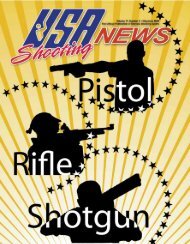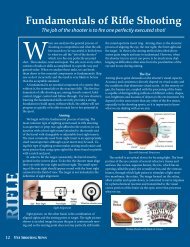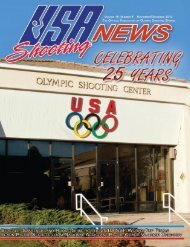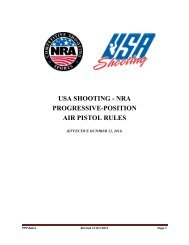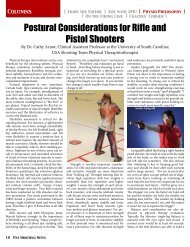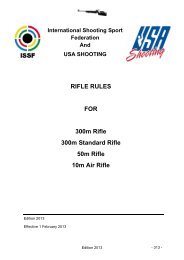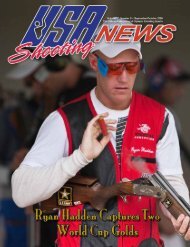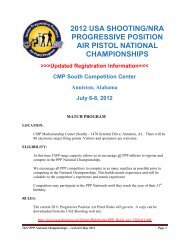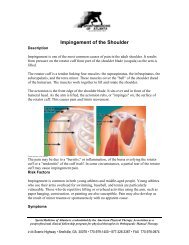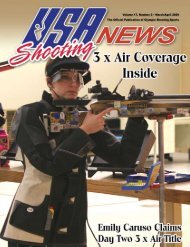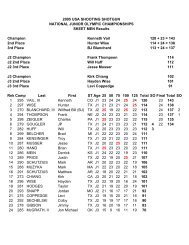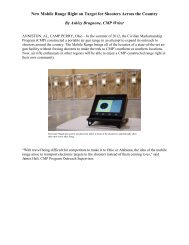January/February 2011: Volume 19, Number 1 - USA Shooting
January/February 2011: Volume 19, Number 1 - USA Shooting
January/February 2011: Volume 19, Number 1 - USA Shooting
Create successful ePaper yourself
Turn your PDF publications into a flip-book with our unique Google optimized e-Paper software.
When introduced to an aperture of appropriate size,<br />
many a rifle athlete has been stunned at the almost immediate<br />
transformation in their shooting. Others have taken a short<br />
time to warm up to the sometimes dramatically changed sight<br />
picture, but ultimately are very pleased with how it feels to<br />
deliver the shot and with the results.<br />
Observant readers will notice that no actual aperture sizes<br />
have been given<br />
thus far. “What<br />
size apertures<br />
do I need for<br />
air rifle and<br />
for smallbore<br />
rifle?” There<br />
is no single<br />
correct answer!<br />
…except this<br />
answer: “It<br />
depends.” One<br />
must know the<br />
value of several<br />
variables<br />
in order to<br />
determine the<br />
correct answer.<br />
What size is<br />
the aiming<br />
Figure 1: Note the very thin front<br />
bull? How far<br />
away is the<br />
aperture ring and the wide white<br />
target? How ring between the aperture ring and far is it from<br />
the surface of the aiming black. Ideally, the front the athlete’s<br />
eyeball to the aperture should be floating as shown aperture inside<br />
(no crossbars) and should usually be<br />
the front sight<br />
globe? Even<br />
a very light salmon (pink) color. This<br />
knowing these diagram is not to scale, and the inner variables, what<br />
is optimal? white ring is often even wider. How do we<br />
know? We must<br />
answer this<br />
question first, in order to determining actual sizes.<br />
Many years ago, Precision <strong>Shooting</strong>, in one of their<br />
magazines or annuals, published an article that discussed<br />
research on front aperture size. It turned out that the width of<br />
the white ring between the front aperture ring and the aiming<br />
black must cover at least three minutes of angle (MOA) from<br />
the shooter’s point of view. Angles are often measured in<br />
degrees, with 360 degrees in a circle. A degree may be further<br />
divided into 60 “minutes”. Thus, 60 minutes of angle (60 MOA)<br />
make up one degree of angle.<br />
About 50 to 60 years ago, the Soviets studied many aspects<br />
of rifle sights and sighting systems, among other things, in<br />
great detail. Front aperture size, aperture ring thickness, and<br />
interestingly, front aperture insert color, were among the<br />
numerous factors studied. For shooting outdoors, they found<br />
light pink apertures to be most effective. Now you know why<br />
Anschutz sells that color! They also found that very thin front<br />
aperture rings were the most effective. Air events were not<br />
studied as they were not part of Olympic shooting at that time.<br />
Sadly, the paper(s) with the results of the research activities<br />
cannot be found; however, references to the studies shed some<br />
light. Taking the published statements and translating them in<br />
terms of MOA, one gets identical results to the above article.<br />
It was interesting to discover that these two different<br />
resources came to the same conclusion. Unfortunately,<br />
there are no other known studies or resources on this topic.<br />
Therefore, a number of empirical observations and informal<br />
studies were performed with athletes at all levels to explore this<br />
topic. In some exercises, athletes used aperture sizes that<br />
were changed randomly for each shot, ranging in size from<br />
very tiny, with almost no white ring between the bull and the<br />
front aperture, all the way to so large the bull seemed to be<br />
floating on its own.<br />
In all cases, when the front aperture size was chosen<br />
to show the athletes a white ring width of 3 MOA or more<br />
(often much more), the athletes felt confident about their<br />
shot delivery, were decisive, had smooth triggering, and<br />
shorter holds. Sometimes the difference was so profound<br />
that the athletes would comment on how much easier it<br />
was to shoot and that the results were better and more<br />
predictable than normal. It was discovered that front<br />
aperture sizes could be larger than the 3 MOA size by as<br />
much as 0.5 mm or more with identical and sometimes even<br />
better effects.<br />
When the aperture size was such that the athlete was<br />
presented with a white ring width that was less than 3 MOA,<br />
even by the tiniest amount, profound changes took place:<br />
confidence took a dive, hold times increased, triggering<br />
became rough, and overall shot delivery was less decisive.<br />
If the aperture size was only 0.1 mm too small, the negative<br />
effects were observed by both coach and athlete.<br />
Remember the minority of coaches and athletes,<br />
and those few elite athletes, with the really big apertures?<br />
Now you know one of their “secret” keys to success. What<br />
about the common advice to change aperture sizes between<br />
positions? What about the advice to try a smaller aperture<br />
in order to decrease the hold area? Be careful! In the case<br />
of an elite athlete with an extremely small hold area in<br />
the sling positions, one might consider a slightly smaller<br />
aperture. The hold area must be considerably smaller than in<br />
the standing position and the athlete must not already have<br />
any issues with decisiveness or clean triggering. Even then,<br />
careful experimentation is required.<br />
In the standing position, some athletes have developed<br />
extremely small holds. (E.g. hold area contained well inside<br />
the diameter of a pellet on the air rifle target.) Again, very<br />
careful experimentation is required.<br />
In both of the above cases, more often than not, the<br />
athlete and coach, even at the elite level, in search of what<br />
they believe is good visual precision, talk themselves into<br />
using an aperture that is too small, rather than obeying all<br />
the signs to the contrary.<br />
However, an increase in size for a shooter with a looser<br />
hold (e.g. a newly beginning shooter’s standing position) is<br />
certainly appropriate. One is well advised in almost every<br />
case to stick with the three MOA rule as the bare minimum<br />
size. One may use an even larger aperture, 0.5 millimeters<br />
or more, with no problem. To go smaller, even by the tenth<br />
of a millimeter, is fraught with serious peril. There are<br />
exceptions, but regardless, it is very rarely safe to assume<br />
you are one of those exceptions. Refer again to the Olympic<br />
jan feb <strong>2011</strong>.indd 7<br />
1/3/<strong>2011</strong> 10:45:56 AM



